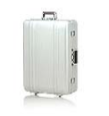Zero Halliburton luggage
Zero Manufacturing, Inc. http://www.zerohalliburton.com/ 1- 801-298-5900
We travel a lot. (One editor is recognized by sight at the airline counter in his home town, and by some of the flight attendants – even overseas! – Oye!)
As with everyone that travels extensively, we have subjected ourselves to light luggage, heavy luggage, fragile luggage, and sturdy luggage. Among us, sturdy luggage has become the luggage of choice, with the aluminum cases from Zero Halliburton (http://www.zerohalliburton.com/) being the clear winners (we have touched on these cases previously in the November 2002, February 2003, and December 2005 issues of ÆGIS).
One of the virtues of sturdy cases is that they are, well, sturdy. As an example, this editor’s first Halliburton case was purchased in 1965 for use as a carry-on bag while in the Peace Corps. Although a bit scuffed up, it is still in regular use. It is, however, considered somewhat dated as it does not have wheels. While not a big deal, all current versions are available with wheels.
 Ignoring for this discussion briefcases (the example of which we got post-Peace Corps and still use), camera cases, makeup cases, and gun cases, other specialty cases, and suitcases too big for air travel (The reduced-to-50-pounds weight limit when checking bags knocked the 32 inch suitcase out. When traveling with paper or for several weeks you may be forced to take two smaller cases instead of one more convenient case, independent of the luggage.), their wheeled-with- pullout-handle luggage comes in four sizes useful to air travelers. The useful sizes are the 21” carry-on (13 x 21 x 9), the 24” (18 x 24 x 9), the 26” (18 x 26 x 9.5), and the 29” (20 x 29 x 10).
Ignoring for this discussion briefcases (the example of which we got post-Peace Corps and still use), camera cases, makeup cases, and gun cases, other specialty cases, and suitcases too big for air travel (The reduced-to-50-pounds weight limit when checking bags knocked the 32 inch suitcase out. When traveling with paper or for several weeks you may be forced to take two smaller cases instead of one more convenient case, independent of the luggage.), their wheeled-with- pullout-handle luggage comes in four sizes useful to air travelers. The useful sizes are the 21” carry-on (13 x 21 x 9), the 24” (18 x 24 x 9), the 26” (18 x 26 x 9.5), and the 29” (20 x 29 x 10).
 In addition, suitcases useful for air travelers are made with wheels on the bottom in the 26” and 29” sizes. Which of these wheeled options you might choose is a matter of personal taste. While the version with the pull-out handles might seem more convenient, in fact we have had no problem rolling through the streets of New York during a transit strike or from customs to car to hotel in Istanbul or Buenos Aires or Hong Kong or Cairo.
In addition, suitcases useful for air travelers are made with wheels on the bottom in the 26” and 29” sizes. Which of these wheeled options you might choose is a matter of personal taste. While the version with the pull-out handles might seem more convenient, in fact we have had no problem rolling through the streets of New York during a transit strike or from customs to car to hotel in Istanbul or Buenos Aires or Hong Kong or Cairo.
Although the cases are near-indestructible (it is rumored that some years ago Algerian separatists emptied a plane of passengers and blew it up on a runway in France, and that the only recoverable items were Halliburton cases), occasionally repairs are needed. We had to replace forty-year-old latches on one case. And, after one trip on an airline now thankfully out of business, we had to bang out a dented corner with a ball peen hammer. More vexing, on older suitcases the internal dividers were held in place by clasps on elastic, and the elastic on one of our decades-old suitcases had lost its stretch. We brought it to Modern Leather Goods Repair Shop, Inc. in New York City, who, after three tries in several hours (and $60) were still unable to even get the elastic sewn on to line up with the fixtures.
Putting aside these minor tribulations, you should expect that any Zero Halliburton case you buy will be happily used by you, and by generations far removed from you.
The price you pay for this is that the suitcases cost more than cheap luggage, albeit competitive with other fine luggage. A 21” carry-on, for example, retails for $625. An equivalent leather Tumi carry-on retails for $795 to $895. The Louis Vuitton Pégase 50 retails for $1,570.
Fortunately, luggage can always be bought at a discount, and the 21” Zero Halliburton carry-on is available for $337.95 at Cambridge World (http://www.cambridgeworld.com/Zero_Halliburton_Bags/zerohalliburton_l uggage.htm).
It has been the experience of these editors that in the long run, the best, most cost-effective choice in luggage for us is the virtually-indestructible aluminum Zero Halliburton case, and we recommend you give these cases serious consideration if you travel extensively.

